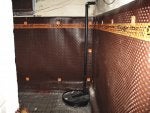I'm working on a basement drainage system and I explained my approach to another DIYer. Their recommendation was not to add weep holes to the block wall, as it could invite new problems. They argue that if the wall has been standing for 50 years it's not going to cave in now from hydrostatic pressure. He just recommended re-applying waterproofing and see what happens at the next snow melt. I've already excavated the trench and sump pit, so am pretty invested in the traditional approach of trench + sump + weep holes.
My argument is not addressing the problem properly could lead to a structural issue at some point (though he is right, the wall has stood for 50 years). Also, adding weep holes would control the leaks predictably, so I wouldn't need to worry about new leaks springing up where I haven't waterproofed.
Any thoughts on this?
Bit of background: 1 wall in our basement leaks after heavy snow melt and rain - there are about 5 points across the wall that leak. It's a weep in most places but more than a trickle in others.
My argument is not addressing the problem properly could lead to a structural issue at some point (though he is right, the wall has stood for 50 years). Also, adding weep holes would control the leaks predictably, so I wouldn't need to worry about new leaks springing up where I haven't waterproofed.
Any thoughts on this?
Bit of background: 1 wall in our basement leaks after heavy snow melt and rain - there are about 5 points across the wall that leak. It's a weep in most places but more than a trickle in others.






